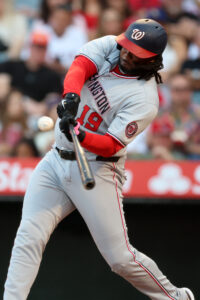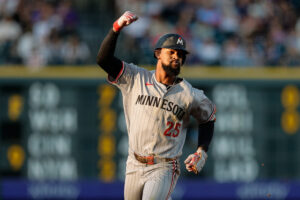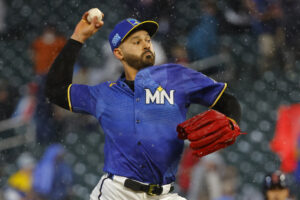
Bell, 33, has been at least an average bat in every season of his decade-long MLB career, with the exception of a poor showing in the shortened 2020 campaign. At times, the former second-round pick and top prospect has looked on the cusp of breaking out as a star-level slugger — most notably in 2019 and 2021 — but he’s never quite produced as the steady power bat one might expect from a hulking 6’3″, 260-pound first baseman.
That’s largely due to the switch-hitting Bell’s penchant for hitting the ball on the ground. Despite his sizable frame and clearly plus raw power, Bell has struggled to maintain a swing path that allows him to elevate the ball. He’s cut his grounder rate in recent seasons, to be fair; last year’s 45.7% mark was actually the second-lowest of his career, ahead of only the 44% mark he posted during a 37-homer campaign back in 2019. However, that 45.7% mark was still well above the 41.8% league average. For a hitter like Bell, whose average sprint speed ranked in just the seventh percentile of big league position players, per Statcast, that much contact on the ground is a clear detriment.
When Bell does elevate the ball, he does so with tremendous authority. Statcast ranked his 96.4 mph average exit velocity on liners/fly-balls 25th among 251 qualified hitters. Bell’s isolated power (slugging percentage minus batting average) of .507 on fly-balls isn’t elite but is well north of the .436 league average. He popped 22 round-trippers this past season and has averaged 26 homers per 162 games over the past seven seasons — despite his proclivity for hitting the ball into the ground. It’s long been thought that if Bell could consistently elevate the ball, he’d be a high-end slugger, but six teams have now tried to get him to do so consistently and been unable to make it happen.
The end result is typically above-average but not elite offense. Bell hit .237/.325/.417 this past season with the Nationals. His 10.7% walk rate was comfortably north of average and roughly in line with his career 11.2% mark. His 16.5% strikeout rate was the second-lowest of his career. Bell had uncharacteristic struggles with his right-handed swing last season but has traditionally been a solid hitter from both sides of the dish (albeit with better production from the left side). His 90.4 mph average exit velocity and 47% hard-hit rate were his best marks since a strong 2021 season (also spent with the Nats).
The Twins and their fans can perhaps find some optimism in the trajectory of Bell’s 2025 season. He was one of the worst hitters in either league through the end of April but busted out of that slump with a huge showing in May. He took a step back in June and then delivered terrific production over the final three months of the year. Setting aside Bell’s awful first 125 plate appearances of the season (when he had a bloated 50% grounder rate, it should be noted), he hit .278/.358/.462 with 17 homers, 16 doubles, an 11.1% walk rate and a 14.6% strikeout rate. In 250 plate appearances from July 2 onward, he slashed .284/.371/.486 (with a ground-ball rate sitting at 42%).
That’ll be the sort of production for which the Twins hope in 2025. Bell figures to be the primary first baseman for new manager Derek Shelton, who briefly overlapped with Bell during his first season as manager in Pittsburgh. Like most teams, the Twins don’t have a set designated hitter, so Bell could get some looks there, too, if the Twins want to free up some first base time to get Edouard Julien or Kody Clemens into the lineup there. Some additional DH reps for Bell would benefit the team defensively; he posted solid grades at first base back in 2021-22, but Bell has been dinged for -20 Defensive Runs Saved and -16 Outs Above Average over his past 1551 innings in the field. He’s not a skilled defender.
Even with those defensive shortcomings, Bell adds a legitimate bat to the middle of Minnesota’s order. He’s a durable veteran, having appeared in 91.5% of his teams’ possible games dating back to his first season as a full-time regular. That’s an average of better than 148 games per year, and it’s reasonable to expect at least 20 home runs based on his track record, with 25 to 30 not out of the question depending on the extent to which he can avoid falling into another grounder-heavy malaise.
Bell joins Byron Buxton, breakout rookie Luke Keaschall and catcher Ryan Jeffers in the top portion of a Twins lineup that’ll hope for better results from talented but inconsistent young hitters like Royce Lewis, Matt Wallner, Brooks Lee and (if he’s not traded) Trevor Larnach. Top prospects Walker Jenkins, Emmanuel Rodriguez and Kaelen Culpepper could force their way into the mix next season. Alan Roden will get another chance to prove his big Triple-A production can play in the majors, too.
The signing of Bell only reinforces the fact that despite a deadline fire sale, the Twins are intent on adding back to the roster in an effort to be as competitive as possible in 2026. President of baseball operations Derek Falvey plans to hold onto stars like Buxton, Joe Ryan and Pablo Lopez rather than trade them. The Twins were reportedly shopping in the middle tiers of the free agent market at first base, and they’ll presumably use some of the modest budgetary space granted by ownership to add some low-cost relievers as well.
Bell adds $5.75MM to the 2026 payroll, boosting the Twins just north of $100MM in the process, per RosterResource. Dan Hayes of The Athletic has previously reported that the front office has about $20MM to spend this winter. That should mean Falvey, GM Jeremy Zoll and the rest of the front office still have a around $15MM to help deepen the bullpen and perhaps the bench. Given that the Twins shipped out a stunning five relievers at July’s deadline, it seems fair to presume they’ll bring in multiple arms (though they already added one with November’s acquisition of Eric Orze from Tampa Bay).
Overall, payroll will still be down considerably from last year’s $142MM Opening Day mark and certainly from 2023’s franchise-record $153MM. Major additions on either side of the ball shouldn’t be expected. If the Twins compete next season, it’ll be due to big steps forward from in-house talents like Lee, Keaschall, Jenkins, Roden, Taj Bradley, Mick Abel and others. If they fall short of contending in a perennially competitive AL Central, then players like Bell and any of the forthcoming bullpen acquisitions could emerge as trade chips alongside Ryan, Lopez, Jeffers and others.
ESPN’s Jeff Passan first reported that the two sides had agreed to a one-year deal with a mutual option. Jon Heyman of the New York Post reported the $7MM guarantee. Bobby Nightengale of The Minnesota Star-Tribune had the salary structure.
]]>
